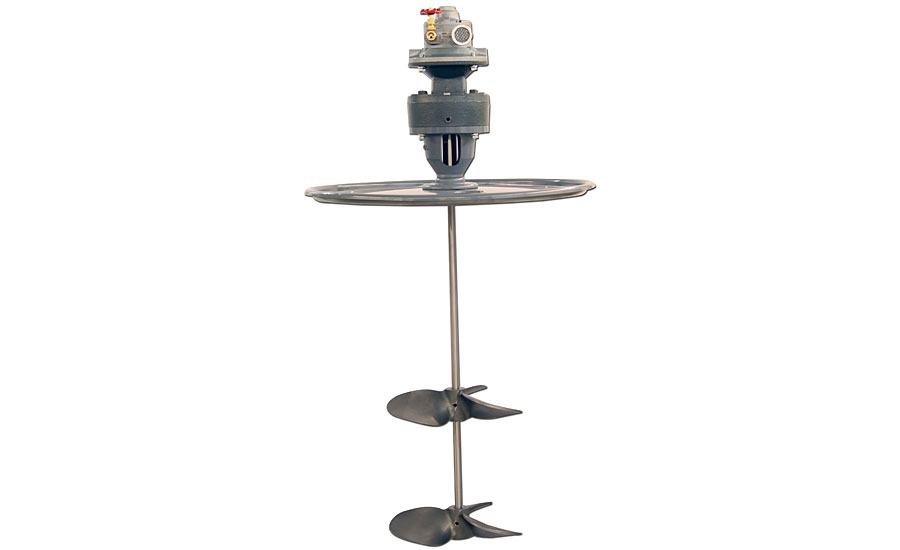Selecting the Right Mixer for Highway and Road Paint Formulations

Marking paints for highways, roads and parking lots are produced in a wide variety of formulations that must meet increasingly strenuous DOT requirements for volatile organic compounds (VOCs), dry times and durability. Furthermore, these products must be suitable for differing regional temperature variations, humidity differences and other application-specific conditions. When researching leading manufacturers’ instructions for utilizing these products, one critical requirement is common to all of them prior to application: thorough mixing!
Traffic and road paint formulations vary relative to density (or specific gravity), viscosity and ingredients, similar to paint products used in other industries. Generally, these include waterborne (latex), plural-component (often epoxy and catalyst) and thermoplastic products. Common containers are intermediate bulk containers (also called IBC totes), 55-gallon drums and 5-gallon pails. Regardless of formulation type, the important properties from a mixer selection standpoint are the density of the materials that must be blended including high solids content, the potential addition of reflective glass beads, the viscosity of the formulation, and the size and geometry of the container in which effective mixing must be achieved.
Densities on traffic paint data sheets are commonly shown as weight per gallon in lbs/gallon. They may also be expressed as specific gravity – the ratio of the product density to that of water. For example, a paint with specific gravity of 1.2 is 1.2 x 8.35 (lbs/gallon for water) = 10.0 lbs/gallon. Viscosity may be expressed in centipoise or in alternative units of measure such as KU (krebs units). Together, these characteristics with consideration for the container size and shape determine the mixer power rating, torque, rpm range, and impeller type and size for successful solids suspension and homogeneous product ready for application.
The following paragraphs discuss these important products from the perspective of industrial mixer selection. Optimal mixing results are based on the formulations’ material properties and the standard containers in which they are sold and distributed.
Highway and Road Paint IBC Tote Mixers
IBC totes are common containers for efficient paint distribution via truck trailers. However, the cubic form that allows them to be easily and efficiently arranged on trailers also makes them less than ideal for thorough mixing. The corners tend to create low-flow areas during mixing, while the relatively small top opening limits the size of mixer that can be employed. These challenges are easily overcome for relatively “thin” paint formulations, i.e. those with water-like properties such as a specific gravity at or close to 1.0 and, importantly, with low viscosity or solids content. Formulations such as these tend to mix easily with economical direct-drive mixers for totes. These typically include a shaft, impellers, and either an air powered or TEFC electric motor that are integrated into a standard tote cap. Standard shaft lengths are 32 inches for 275-gallon totes, and 39 inches for 330-gallon totes. Both sizes are lightweight, and can be installed and removed from the tote by a single operator. The air or electric motor decision is typically determined by the operational environment and/or utilities available.
Air-powered and pneumatic models require air pressure at specific volumes to achieve full rated performance. Consult manufacturer’s technical data for required air supply, or speak to one of their engineers. Furthermore, the air-driven models and explosion-proof electric versions are the preferred options for solvent-based formulations. INDCO TL-series mixers are well suited for “thin” or light-viscosity formulations in standard IBC totes. BT-series mixers are available for operators desiring direct drive mixers with tote-mounting brackets.

Heavier and more viscous road paint products, those with specific gravities from 1.4-1.6 (11.7-13.4 lbs/gallon) and viscosities of 600-1,700 centipoise, require heavy-duty mixers with larger impellers and gear reducers for added torque. This extra torque is required for the mixing of high-viscosity formulations as well as the re-suspension of settled materials. The higher specific gravity directly determines the torque and horsepower ratings of the mixer motor and gear reducer that are required to drive larger-diameter impellers. Larger impellers are required to physically contact and circulate more of the flow-resistant, high-viscosity material, especially in the less-than-optimal, cube-shaped IBC square tote. Solid mounting brackets stabilize the mixer during use, and either clamp to the tote or connect to the tote cage using toggle clamps. Models with air or electric motors are available in standard or explosion-proof configurations, as determined by the operational environment of the mixer and/or available utilities. INDCO BG-series mixers are ideal for mixing heavier highway and traffic paints in standard IBC totes.
Highway and Road Paint 55-Gallon Drum Mixers
The 55-gallon drum is a standard container for paint and chemical products. Although not cubic in shape like IBC totes, they can offer their own challenges to mixing paints or suspending settled solids. The same considerations for selection between direct-drive or gear-driven models and air-powered vs. electric models apply based on the properties of the paint. From there, mixer selection may be determined by the drum configuration – closed or open top, center mounted or bung entering, etc.
Drum mixers that are integrated into a standard 55-gallon drum lid are common for open-top drums. Models including air-powered, electric or explosion-proof electric, are suitable for heavy-bodied traffic paints. When the drum top can be left open, a rigid mounting bracket with a mixer works well. Pitched blade turbine impellers for maximum surface area contact provide optimal agitation in 55-gallon drums. INDCO DLG-series mixers are well suited for open-top drums, while BM-series fill the need for rigid bracket mounting. Bung-entering models are available for low-viscosity applications but are generally not recommended for heavy traffic paints due to the small impeller sizes limited by the small openings.

Highway and Road Paint Five-Gallon Pail Mixers
For small residential roadways or parking lot jobs, a five-gallon pail may be the appropriate paint volume. Solids settle during storage and transportation, making pre-application mixing an important step. There are a variety of pail mixer product formats to assist with this task, including heavy-duty, top-mounted electric or pneumatic models. These mixers often feature a ring-shaped frame that attaches to the outside diameter of the pail with a thumb screw and provides high-torque mixing with 9”, two-bladed impellers. For mixing heavy-bodied products in a facility, a benchtop-mounted lift-style mixer secures the pail while agitation is provided by axial flow turbine impellers. INDCO FGM-series pail mixers provide the torque needed for mixing road paint in five-gallon pails, while MX-series mixers are ideal for benchtop applications. In addition, there are many varieties of handheld mixers and drill attachments for quick field applications.

Conclusion
Choosing the correct mixer for highway and road paint is critical to achieving the desired product consistency prior to application. Factors such as viscosity, solids content and mixing containers all play into the decision on which mixer is best suited for the task. When in doubt, confer with the mixer manufacturer. Their engineering staff should be able to direct you to a suitable solution.
*All photos courtesy of INDCO.
Looking for a reprint of this article?
From high-res PDFs to custom plaques, order your copy today!








